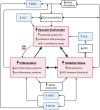Vascular Health Triad in Humans With Hypertension-Not the Usual Suspects
- PMID: 34658930
- PMCID: PMC8517241
- DOI: 10.3389/fphys.2021.746278
Vascular Health Triad in Humans With Hypertension-Not the Usual Suspects
Abstract
Hypertension (HTN) affects more than one-third of the US population and remains the top risk factor for the development of cardiovascular disease (CVD). Identifying the underlying mechanisms for developing HTN are of critical importance because the risk of developing CVD doubles with ∼20 mmHg increase in systolic blood pressure (BP). Endothelial dysfunction, especially in the resistance arteries, is the primary site for initiation of sub-clinical HTN. Furthermore, inflammation and reactive oxygen and nitrogen species (ROS/RNS) not only influence the endothelium independently, but also have a synergistic influence on each other. Together, the interplay between inflammation, ROS and vascular dysfunction is referred to as the vascular health triad, and affects BP regulation in humans. While the interplay of the vascular health triad is well established, new underlying mechanistic targets are under investigation, including: Inducible nitric oxide synthase, hydrogen peroxide, hydrogen sulfide, nuclear factor kappa-light-chain-enhancer of activated B cells (NF-κB) and nuclear factor activated T cells. This review outlines the role of these unusual suspects in vascular health and function in humans. This review connects the dots using these unusual suspects underlying inflammation, ROS and vascular dysfunction especially in individuals at risk of or with diagnosed HTN based on novel studies performed in humans.
Keywords: blood pressure; endothelium; inflammation; oxidative stress; reactive oxygen species.
Copyright © 2021 Ranadive, Dillon, Mascone and Alexander.
Conflict of interest statement
The authors declare that the research was conducted in the absence of any commercial or financial relationships that could be construed as a potential conflict of interest.
Figures

References
Publication types
Grants and funding
LinkOut - more resources
Full Text Sources

